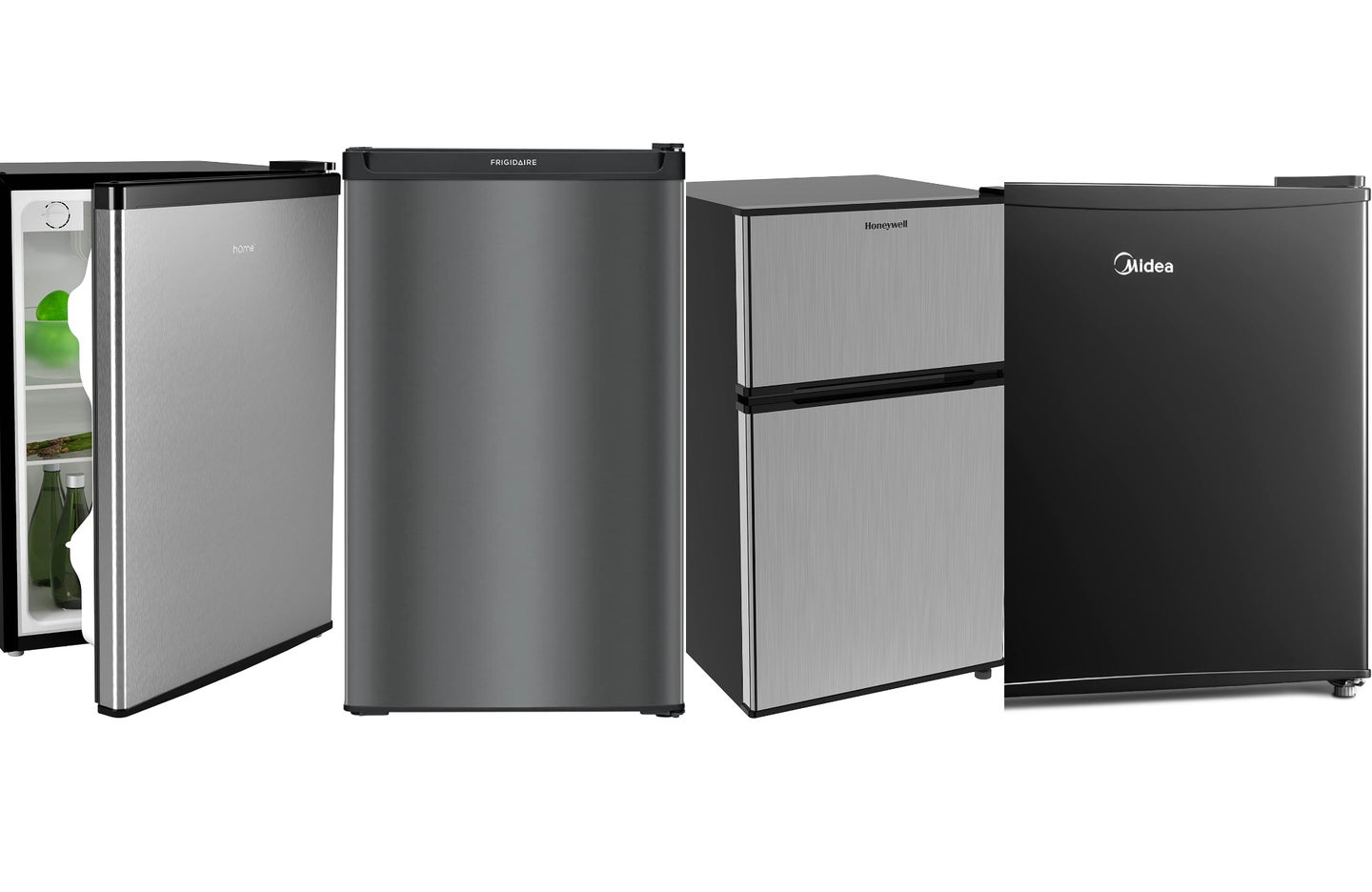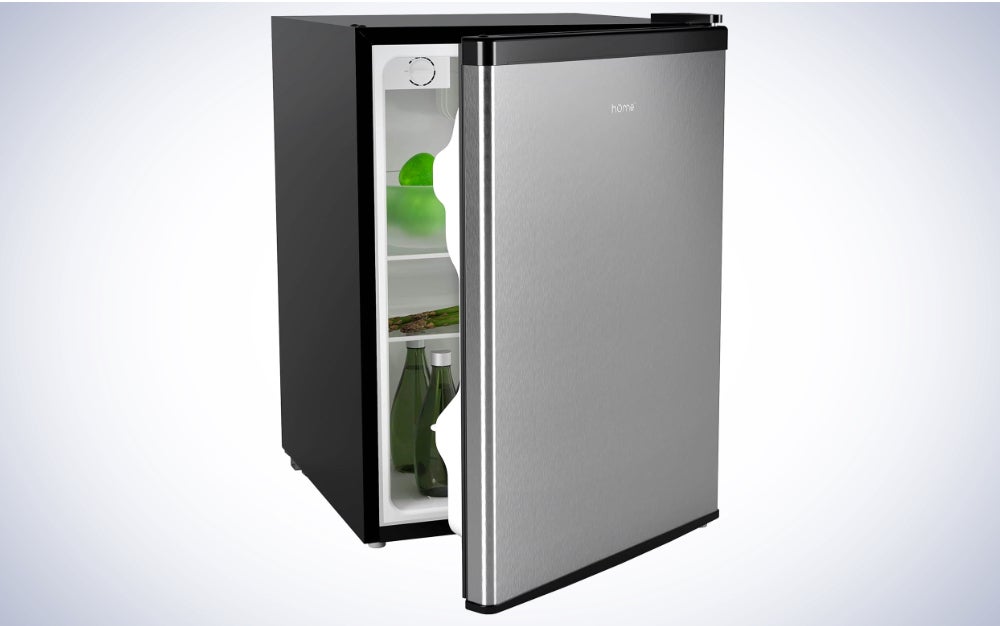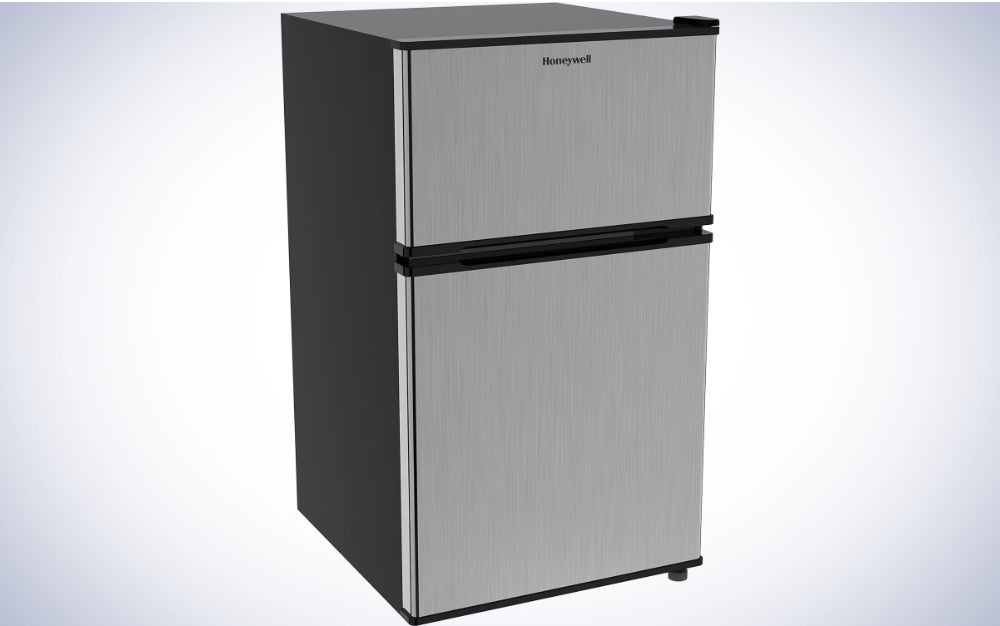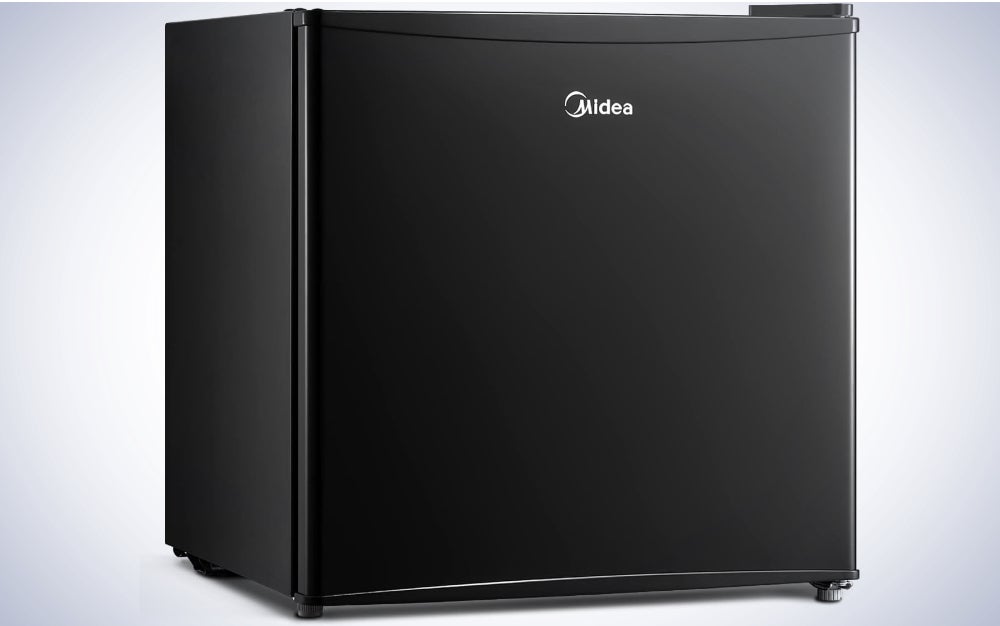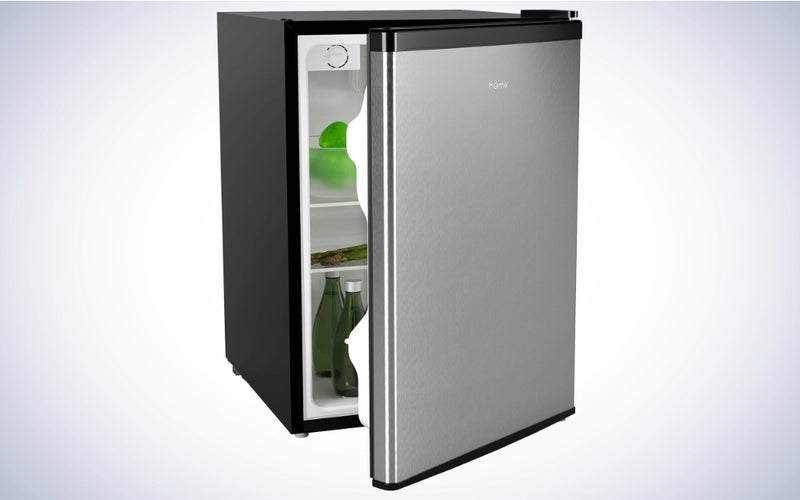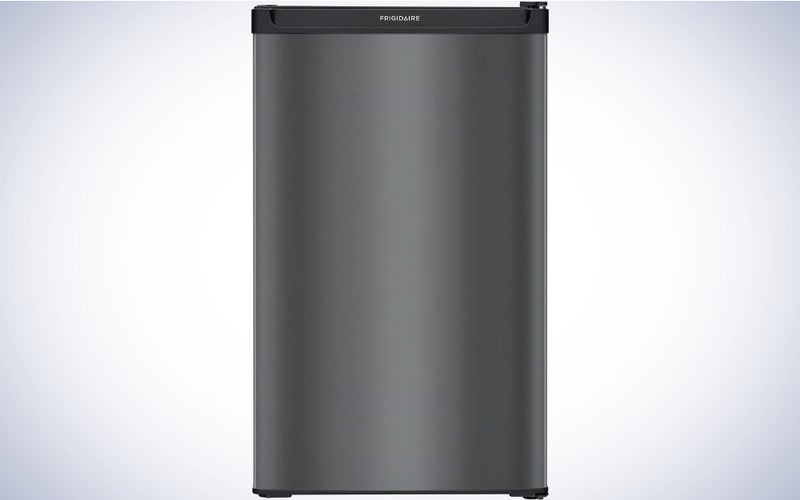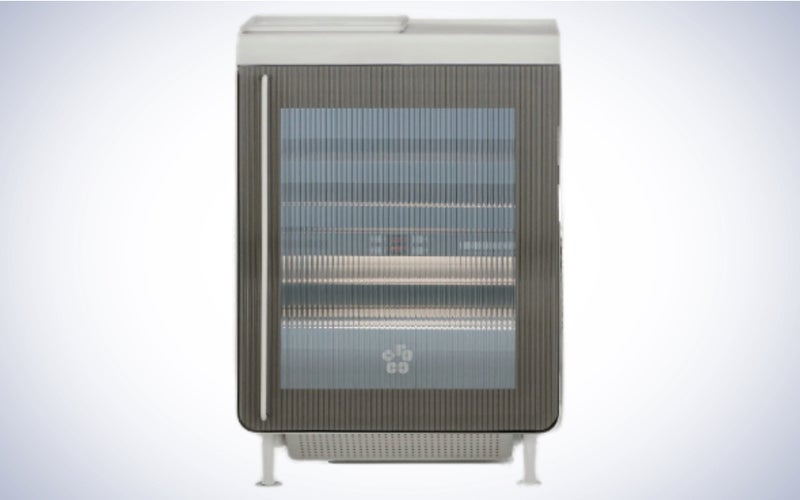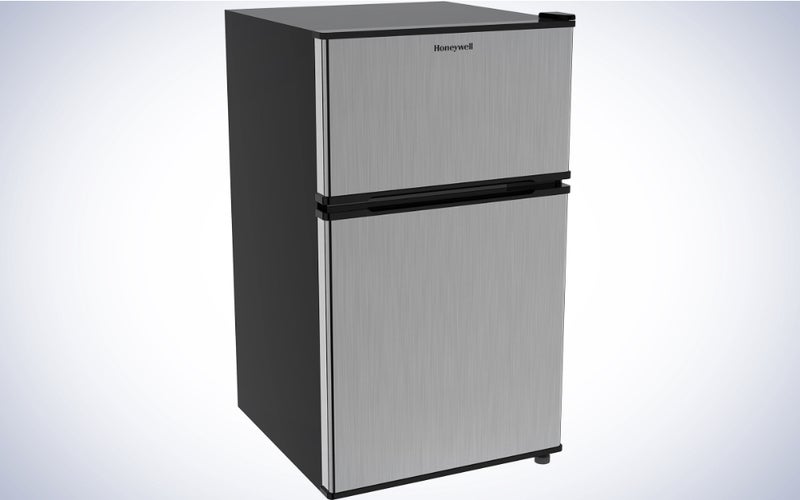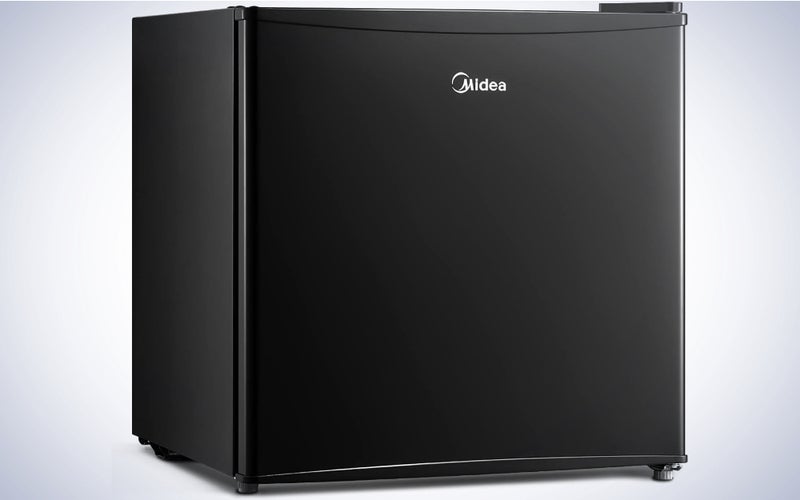We may earn revenue from the products available on this page and participate in affiliate programs. Learn more ›
The mini fridge is a staple of dorm rooms, home offices, basements, hotel rooms, and any place you need cold beverages on hand without taking up much space. These mini drink dispensers are roughly half the size of a “normal” fridge, but their lower capacity and tinier footprint are the point. A bedroom fridge tucked in a corner can save you trips up and down the stairs, which is especially helpful at night. Similarly, one in the garage, TV room, etc., lets you concentrate on your task or TV. The best mini fridges provide undeniable utility wherever they’re installed, and they’re a relatively inexpensive appliance upgrade.
- Best overall: hOmeLabs Mini Fridge
- Best design: Frigidaire Compact Refrigerator
- Best splurge: Rocco Super Smart Fridge
- Best with freezer: Honeywell 3.1 Cu Ft Mini Fridge with Freezer
- Best budget: Midea WHS-65LB1 Compact Single Reversible Door Refrigerator
How we chose the best mini fridges
Our mini fridge recommendations are based on analysis and research into the best options to accommodate the most common use cases. Many of the best-known full-sized fridge makers also make mini fridges, so if you have brand loyalty (or just like consistency) you’re likely in luck. We focused on general-purpose mini fridges rather than a wine cooler, which is a similar but specialized appliance.
A mini fridge, much like a beverage cooler, has one job: keep drinks and food cold for an extended period of time. Some have a particular feature, like a built-in freezer, differentiating them from the pack, while others are more portable and easier to move around. Mini fridges can also vary some in price, so we included a more premium and cheap mini fridge to cover the widest budget range.
The best mini fridges: Reviews & Recommendations
Having cool beverages on hand is an attainable luxury and one that doesn’t require a cooler with wheels. Once you get used to having one of these mini fridges, you’ll wonder how you did without it.
Best overall: hOmeLabs Mini Fridge
hOmeLabs
Specs
- Size: 17.4″D x 20.1″W x 24.5″H
- Minimum temperature: 34°F
- Capacity: 2.4 Cubic Feet
- Style: Tall
- Price: $269.99
Pros
- Mid-sized
- Height-adjustable shelves
- Freezer compartment
Cons
- May not be large enough for your needs
The hOmeLabs Mini Fridge tries to be the Goldilocks of this product category. It’s not too big, not too small, and even has a freezer compartment—complete with its own temperature gauge—rather than a separate door. This makes it just right for most people. You can move its two shelves to four height levels to accommodate differently sized bottles and cans or remove one entirely if you’d like to chill a bottle of wine or a two-liter of water, seltzer, or soda. A pair of shelves built into the mini fridge’s door offers even more space, and metal bars will keep bottles from falling out when you open and shut the fridge.
This mini fridge’s built-in freezer isn’t that large but can hold a few pints of ice cream or ice cube trays if need be. Smaller frozen dinners could also fit inside if you’d like to keep them inside to microwave later. This mini fridge’s middle-of-the-road size is its greatest strength and only potential weakness. It’s just large enough to hold a couple dozen cans along with other perishables, but may not be big enough if multiple people are sharing it. If you’re on your own, we can’t find fault with this mini fridge, but if you’re planning to install it in a common space you may want something a bit bigger.
Best design: Frigidaire Compact Refrigerator
Frigidaire
Specs
- Size: 18.5″D x 20″W x 34″H
- Minimum temperature: 33°F
- Capacity: 3.2 Cubic Feet
- Style: Tall
- Price: $255.64
Pros
- Modular shelving system
- Large capacity
- Ample door storage
Cons
- No freezer
All mini fridges have the same basic design, but this model from Frigidaire has a couple of subtle extras that make it more versatile and convenient to use. The fridge comes with three removable shelves that can be moved to ten different positions. This is an extraordinary amount of flexibility to accommodate cans, bottles, and food storage containers of every shape and size. The door of Frigidaire’s fridge isn’t as modular as its main compartment, but it still has some convenient features.
First, the six can slots are angled outward, which makes them easier to reach for and grab immediately. A pair of shelves to the right of them can be used for small jars and taller cans or bottles, respectively. Finally, the bottom shelf is deep and wide enough to hold gallon-sized containers of milk, or bottles of wine and soda. It doesn’t have a freezer section, but we can forgive that, given the rest of its design.
Best splurge: Rocco Super Smart Fridge
Rocco
Specs
- Size: 16″D x 24″W x 34″H
- Minimum temperature: 37°F
- Capacity: N/A
- Style: Tall
- Price: $1,500
Pros
- Can accommodate bottles of all shapes and sizes
- Controllable via an app
- 10-year warranty
Cons
- Price
This mini fridge may be designed for beverages, but it’s also one of the most innovative appliances we’ve seen in quite some time. Rocco’s Super Smart Fridge has five pull-out shelves, which can be adjusted to accommodate differently sized bottles and cans. These shelves can be separated into different “temperature zones” by pushing buttons on a control panel inside the fridge. This means your white wine and seltzers can be chilled to their ideal temperature individually.
Rocco doesn’t measure its mini fridge’s capacity in cubic feet but by how many bottles and cans it can hold. In one example, the fridge held five bottles of wine and 22 sodas (a mixture of bottles and cans), but your experience will vary based on what you’d like to keep chilled. You can keep an inventory of what you’ve got inside the mini fridge broken down by rack.
At $1,500, this mini fridge is a textbook definition of the term splurge, so the company offers a decade-long warranty with purchase against defects.
Best with freezer: Honeywell 3.1 Cu Ft Mini Fridge with Freezer
Honeywell
Specs
- Size: 19.4″D x 18.5″W x 32.9″H
- Minimum temperature: N/A
- Capacity: 3.1 Cubic Feet
- Style: Tall
- Price: $205.31
Pros
- Separate freezer compartment
- Fridge and freezer have in-door storage
- Produce drawer
Cons
- Limited modularity
A mini fridge freezer is very helpful to have if you’d like to use the appliance for more than just keeping drinks and leftovers cool for a few days. Honeywell’s mini fridge has a totally isolated freezer, complete with its own door and in-door storage area. It’s larger than the small freezer section built into hOmelabs’ mini fridge, and can easily hold a week’s worth of frozen dinners, ice cream, and other frozen treats.
This mini fridge’s freezer takes up a fair chunk of space, which does come at the expense of modularity. You can’t move this fridge’s shelves to different positions the same way you can with most models. This limits what you can store in the fridge’s main chamber, although the bottom shelf is actually a vegetable crisper, which makes this the best mini fridge for storing produce.
Honeywell made up for this mini fridge’s limited modularity by optimizing its in-door storage. There are two shelves and a vertical can dispenser in the door, which can hold most beverages. If you want the flexibility to freeze food from your mini fridge before it goes bad or to keep frozen foods inside when you don’t have time to cook, this is the one to get.
Best budget: Midea WHS-65LB1 Compact Single Reversible Door Refrigerator
Midea
Specs
- Size: 17.7″D x 18.6″W x 19.4″H
- Minimum temperature: 32°F
- Capacity: 1.6 Cubic Feet
- Style: Cube
- Price: $135.21
Pros
- Compact size
- Built-in chiller box
- Price
Cons
- May not be large enough
If your space requirements are sparse, Midea’s Compact Single Reversible Door Refrigerator is the solution you’re looking for. While it has roughly half the capacity of our other mini fridge recommendations, Midea squeezed a lot of features into this square-shaped box. The biggest surprise is its chiller box, which will keep frozen foods or ice from melting.
There’s also ample in-door storage, with shelves purposefully cut out for a large bottle and smaller ones. This mini fridge only has one rack, which is understandable given its size. You can’t adjust its height, but you can remove it completely if you’d like to use the fridge with tall bottles or stacks of leftovers only. If your needs and budget are modest, Midea’s mini fridge gives you most of the features you’d find in large models in a smaller package.
What to consider when shopping for the best mini fridge
With so many options, choosing the right mini fridge for your home requires careful consideration. These were the factors we had in mind during our research.
Size and capacity
Size is critically important to consider when choosing a mini fridge. A mini fridge’s capacity is measured in cubic feet, and most models fall between 1.5 to 4 cubic feet. You’ll also need to consider the two fridge styles:
- Cube — sometimes called countertop — fridges have capacities of less than 2 cubic feet. They’re generally between 17 and 21 inches tall, 18 and 22 inches wide, and 17 to 22 inches deep. This makes them compact enough to fit under a desk or on a shelf.
- Tall mini fridges are freestanding and have capacities between 3.5 and 4.5 cubic feet. They tend to be 30 to 35 inches tall, 18 to 24 inches wide, and 19 to 26 inches deep.
Aesthetics
Since a mini fridge will be placed in a visible location, you should consider how it looks (though not at the expense of how it performs). Many cheap mini fridges simply come with a black or white finish, while more premium models have stainless steel exteriors.
Additional features
Mini fridges all share the same basic feature of keeping your food and beverages cool, but many have desirable additional features.
- Temperature Control: Many models allow users to control the fridge’s internal temperature using a built-in thermostat.
- Adjustable Shelves: This feature lets you configure your fridge to suit your specific needs best. This is helpful because the contents of your mini fridge can change from week to week or even daily.
- Integrated Freezers: Some mini fridges include a small freezer compartment, which is ideal for storing ice cubes. These aren’t as performant as dedicated, separate freezers and can’t hold as much inside.
- Two-Door Design: Two-door mini fridges have a separate freezer that offers higher performance and can maintain lower temperatures.
FAQs
Q: Do mini fridges use a lot of electricity?
Most of the mini fridges we’re recommending use around 220kw (kilowatt hours) per year, which translates to roughly $30 annually.
Q: Do mini fridges keep food cold enough?
Yes. According to the FDA, refrigerators should be kept at a temperature of 40 degrees Fahrenheit or lower to guarantee food safety. All of the mini fridges above can maintain a temperature in the 30s.
Q: Can one person carry a mini-fridge?
Most of our mini fridge recommendations weigh between 40 and 50 pounds, so we recommend two or more people carry them around.
Q: How much is a good quality mini fridge?
All of our mini fridges should last you several years and range in price between $129.99 and $1,499.99. A majority fall under $300.
Q: Do mini fridges need maintenance?
Mini fridges require the same amount of maintenance as a full-sized refrigerator. Wiping down its shelves with an all-purpose cleaner and dish towel each time it’s emptied out is the only maintenance you should have to perform, barring a technical glitch.
Final thoughts on the best mini fridges
- Best overall: hOmeLabs Mini Fridge
- Best design: Frigidaire Compact Refrigerator
- Best splurge: Rocco Super Smart Fridge
- Best with freezer: Honeywell 3.1 Cu Ft Mini Fridge with Freezer
- Best budget: Midea WHS-65LB1 Compact Single Reversible Door Refrigerator
A mini fridge is a single-purpose appliance that’s easy to overlook but provides a lot of genuine utility in a dorm or home office setting. It can be annoying to leave your room and potentially ruin your flow state just to get a bottle of water or other beverage. Similarly, if your home theater system is located in a basement, it’s far more convenient to have a mini fridge on hand when you’d like to grab a snack. Working on a project in the yard and hate having to head back into the house for a cold one? Add one of our top mini fridges to the shed and you won’t have to.
Why trust us
Popular Science started writing about technology more than 150 years ago. There was no such thing as “gadget writing” when we published our first issue in 1872, but if there was, our mission to demystify the world of innovation for everyday readers means we would have been all over it. Here in the present, PopSci is fully committed to helping readers navigate the increasingly intimidating array of devices on the market right now.
Our writers and editors have combined decades of experience covering and reviewing consumer electronics. We each have our own obsessive specialties—from high-end audio to video games to cameras and beyond—but when we’re reviewing devices outside of our immediate wheelhouses, we do our best to seek out trustworthy voices and opinions to help guide people to the very best recommendations. We know we don’t know everything, but we’re excited to live through the analysis paralysis that internet shopping can spur so readers don’t have to.
